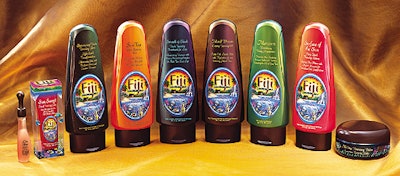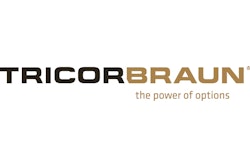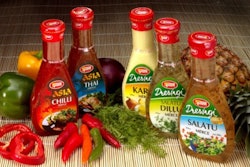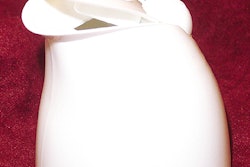Fiji Blend, Inc., Santa Monica, CA, needed to make waves with a proprietary line of products for indoor tanning salons that would gain instant attention in a crowded product category.
Chief operating officer Scott Freeman recalled seeing a container with a color effect—Spectrachrome™ from Clariant Masterbatches (Charlotte, NC)—at a personal care products trade show.
“I’d seen a sample bottle that shimmered like jewels,” says Freeman. “That was what we needed—a package that you remembered two days or even two years later. This industry traditionally uses low-end, predominantly brown bottles. That was not the answer for Fiji Blend, especially when we were introducing a brand new line. We needed ‘pop and presence,’ and that is what we got.”
Selective color shift
The shimmering effect results from the Spectrachrome colorant. Based on light refraction, Spectrachrome creates a selective color shift. The special colorant is usually used on the outer layer of coextruded containers. The effect can also be modified by changing the base color in the inner layer, which acts as a light absorber or reflector depending on the shade selected. The package’s colors appear to shift as people walk by.
The nine Fiji Blend products comprise six 10.1-oz high-density polyethylene inverted tubed bottles, or tottles, of dark tanning lotion (suggested retail price is $35-$40); a 6.7-oz polypropylene jar of All-Over Bronzing Balm (SRP is $35); Loss Gloss lip gloss ($12) in an 11-mL plastic vial; and a 1.7-oz coextruded tube of Sun Swept Facial Tanning Crème ($20) in a clear plastic carton. All but the lip gloss features the Spectachrome color-shifting colorant. It is the first time that the Spectrachrome colorant has been used this extensively in a product line.
Distribution and project management for Fiji Blend’s containers were handled by TricorBraun (St. Louis). The two-layer HDPE tottles are blow molded by Precision Blow Molding (Fullerton, CA). The tottles use a widemouth 26-mm flip-snap cap from Seaquist Closures (Mukwonago, WI). The SimpliSqueeze® closure is injection-molded of polypropylene and silicone. The tube is also a coextrusion, of low-density PE, but the Spectrachrome-enhanced jar is monolayer PP. Fiji declines to disclose further packaging details.
The Spectrachrome color shifts used in the tottles are red-gold-orange, a blue-green-purple, and a bronze-gold-green. For example, the red-gold-orange effect used for the Sun Tea Dark Tanning Brew has an inner layer of red HDPE. The design work for the containers was conducted at the Clariant ColorWorks™ Technical and Design Center in McHenry, IL. Clariant’s director of creative development Len Kulka says that the selection of base pigments for the single-layer jar along with its refractive Spectrachrome pigments was more critical than the two-layer tottles. “There needed to be some light transmission into the container wall to get the full effect into a single-layer container,” Kulka explains.
The Spectrachrome effect is exotic, yet the material runs within conventional processing parameters and cycle times, and does not require special tooling, according to Clariant. The colorant is provided to the molder as pellets. The percentage of the colorant used in the outer layer is below 10%.
Fiji Blend also put plenty of effort into the label. Used on the tube and on the tottles, it was designed in the style of famous marine artist Wyland, according to Fiji Blend director of marketing Yana Simone. “The highly detailed label is designed to evoke the feeling of being on vacation at luxurious Fiji.”
The label features holographic effects in the word “blend” under the Fiji Blend brand name and in mimicking sunlight sparkling on water. Simone won’t provide label specifications other than that it is printed in eight colors.
Show stoppers
In addition to the technical details of the package development, there were also scheduling pressures—the packaged products had to debut at the annual Indoor Tanning Association World Expo in November ’02, Simone says.
“We wanted a dramatically different package and that is what we got,” Freeman says. “When we introduced the line at [ITA], we received a fantastic response.
“People were really impressed, there’s nothing else out there like it,” adds Simone. “One of the most frequent comments we’re getting is that people love the packaging and how it stands out on shelves—especially in tanning salons where other products are also displayed. The products draw consumer response because they are so beautiful.
“Sales have exceeded what we expected, and packaging plays a very major role in that. We’re very proud of how the packaging looks, and the market response attests to that.”
The company looks to expand the products with additional colors and packages this year.


























